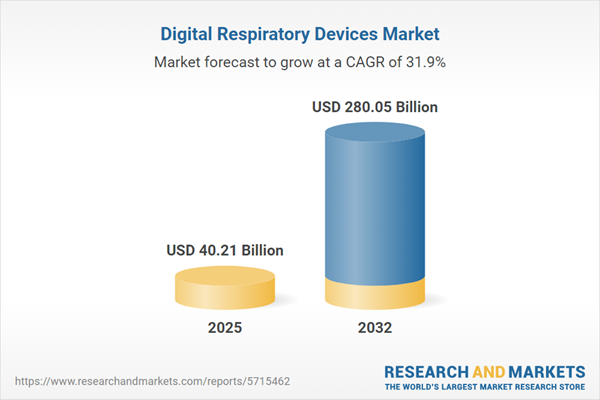Speak directly to the analyst to clarify any post sales queries you may have.
The digital respiratory devices market is rapidly modernizing the delivery of respiratory care, empowering organizations to implement data-driven strategies that enhance both patient outcomes and operational performance. Senior leaders are leveraging these technologies to adopt a patient-focused, efficient approach within evolving healthcare environments.
Market Snapshot: Digital Respiratory Devices Market Trends & Growth
The global digital respiratory devices market demonstrates robust expansion, currently valued at USD 30.61 billion in 2024 and forecast to reach USD 40.21 billion by 2025. Supported by a CAGR of 31.87% through 2032, this momentum is driven by increased digital health adoption, a rising prevalence of chronic conditions, and a shift toward personalized care pathways. Senior decision-makers are prioritizing connected tools such as telehealth platforms, remote monitoring, and the Internet of Medical Things (IoMT) to optimize care delivery and comply with evolving regulatory frameworks. Organizations employing these technologies experience measurable process improvements and enhanced patient engagement in diverse care settings.
Scope & Segmentation of the Digital Respiratory Devices Market
Comprehensive segmentation of the digital respiratory devices market gives leaders clear visibility into prevailing opportunities, risks, and investment priorities. By addressing these strategic dimensions, organizations can strengthen their planning, drive growth, and build operational resilience:
- Product Types: Nebulizers support precise medication delivery; oxygen concentrators provide continuous respiratory support; peak flow meters encourage proactive home-based assessment; sleep apnea devices enable clinical and home treatment; spirometers and ventilators meet needs across age groups, including pediatrics and geriatrics.
- Mode of Operation: Invasive and noninvasive device options support broad clinical requirements and flexible deployment in residential settings.
- End Users: Ambulatory care centers, hospital respiratory teams, specialist clinics, and home health providers drive adoption of connected technologies in both inpatient and outpatient scenarios.
- Distribution Channels: Institutional purchasing, specialist digital suppliers, and pharmacies form dependable routes to market, ensuring rapid device access and broad coverage.
- Therapeutic Areas: Asthma, chronic obstructive pulmonary disease (COPD), cystic fibrosis, and sleep-disordered breathing remain key therapeutic priorities, with digital solutions advancing public health and addressing critical gaps.
- Geographies: The market spans North America, Europe, Central and Latin America, Middle East, Africa, and Asia-Pacific. Momentum is especially notable in China, India, Southeast Asia, and Japan due to accelerated adoption and innovation.
- Key Companies: Influential players shaping the sector include Koninklijke Philips N.V., ResMed Inc., Medtronic plc, Fisher & Paykel Healthcare, Becton Dickinson and Company, Smiths Medical, Drägerwerk AG & Co. KGaA, Getinge AB, Nihon Kohden Corporation, and General Electric Company.
Key Takeaways for Senior Decision-Makers
- Wireless connectivity and advanced data analytics support tailored care interventions and efficient clinical decision-making throughout patient pathways.
- Telehealth and IoMT-enabled monitoring expand access to specialist expertise, strengthening team collaboration and oversight across distributed care models.
- Enhanced device usability improves patient adherence, streamlines onboarding, and enables fast deployment in both clinical and home care environments.
- Streamlined regulations and efficient reimbursement workflows enable timely device market entry and smoother scaling of respiratory programs.
- Collaboration among leading manufacturers, providers, and research organizations accelerates clinical innovation and ensures compliance with shifting requirements.
- Expanding accessibility to digital respiratory devices supports equity of care, especially in underserved and rapidly developing regions worldwide.
Tariff Impact and Supply Chain Response
Recent changes in U.S. tariffs have introduced supply chain complexities for digital respiratory devices. Healthcare organizations are responding by diversifying suppliers, prioritizing local sourcing, and refining procurement strategies. These adjustments strengthen operational continuity, mitigate exposure to trade policy fluctuations, and help maintain consistent device availability. Collaborative value chain management further supports reliable access to critical technologies in respiratory care.
Research Methodology & Data Sources
This analysis draws from a thorough review of academic research, current regulatory filings, industry whitepapers, and expert interviews spanning clinical, technical, and procurement domains. Scenario modeling underpins actionable recommendations for adopting and scaling digital respiratory technologies within various care models.
Why This Report Matters
- Clarifies regulatory trends and operational best practices to successfully integrate digital respiratory devices within healthcare systems.
- Delivers both regional and global insights to support strategic market entry, targeted growth initiatives, and informed partnership development in digital health.
- Prepares healthcare leaders to anticipate reimbursement changes and build organizational adaptability amidst ongoing industry transformation.
Conclusion
By investing in digital respiratory devices and adopting agile supply chain strategies, healthcare organizations can improve clinical outcomes and achieve durable market positioning. Strategic collaboration and adaptability are essential for continued value creation in respiratory care.
Additional Product Information:
- Purchase of this report includes 1 year online access with quarterly updates.
- This report can be updated on request. Please contact our Customer Experience team using the Ask a Question widget on our website.
Table of Contents
3. Executive Summary
4. Market Overview
7. Cumulative Impact of Artificial Intelligence 2025
Companies Mentioned
The companies profiled in this Digital Respiratory Devices market report include:- Koninklijke Philips N.V.
- ResMed Inc.
- Medtronic plc
- Fisher & Paykel Healthcare Corporation Limited
- Becton Dickinson and Company
- Smiths Medical (Smiths Group plc)
- Drägerwerk AG & Co. KGaA
- Getinge AB
- Nihon Kohden Corporation
- General Electric Company
Table Information
| Report Attribute | Details |
|---|---|
| No. of Pages | 184 |
| Published | October 2025 |
| Forecast Period | 2025 - 2032 |
| Estimated Market Value ( USD | $ 40.21 Billion |
| Forecasted Market Value ( USD | $ 280.05 Billion |
| Compound Annual Growth Rate | 31.8% |
| Regions Covered | Global |
| No. of Companies Mentioned | 11 |









